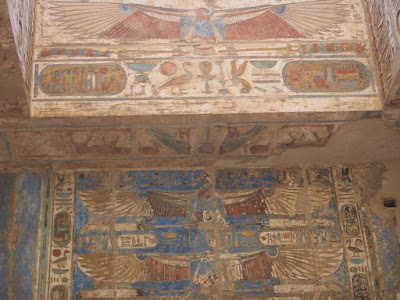Medinet Habu is the mortuary temple of Ramesses III. Ramesses III was Pharoah around 1180-1150 BC and ruled for 31 years. During this time, Egypt was constantly under assault by the "Sea People's", a confederation of tribes, mostly from the area of modern day Israel and Lebanon, as well as, from Libya and Sardinia, trying to establish control of the eastern Mediterranean.
Many of the reliefs on the walls of this temple are dedicated to Ramesses III's battles to fight off these invasions. While he was mostly successful in warding them off, the battles so drained the Egyptian economy that it began the steady decline of the Egyptian power base.
 |
| This relief shows the Pharoah showing no mercy on "Sea People" invaders |
It is known that Egypt suffered a major setback at around year 29 of Ramesses III reign due to an extended drought and poor growing conditions. This led to an emptying of the grain stores and a major workers strike. Recent evidence now shows that perhaps the Hekla 3 eruption in Iceland at that same time put up so much ash into the air that growing conditions declined worldwide.
 |
| Ceilings tend to have the most surviving paint in the temples because they are most protected from winds and rain |
Egypt would never be the same. Their international influence would be weakened dramatically, for which they would never recover, as they soon lost control of most of their colonies in West Asia.
While the Pharoahs would continue to rule Egypt proper for another 400 years, it is interesting that a volcanic eruption thousands of miles away may have been the straw that broke the camel's back of the massive power of the Egyptian empire that had lasted for thousands of years.












No comments:
Post a Comment